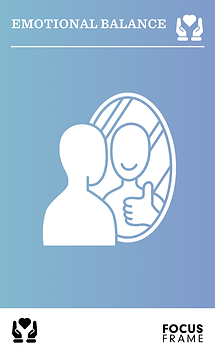Working with Anticipation
Emotional Balance
About This Practice
Anticipation anxiety often shows up before events like meetings, presentations, or important conversations. It’s driven by the brain’s tendency to project fear into the future, activating the amygdala and triggering a fight-or-flight response—even in non-threatening situations. The result? Racing thoughts, a pounding heart, or a sense of dread.
Using the Focus Frame gives you a visual and physical way to break out of these future-focused spirals and return to the present moment. It’s a tool to interrupt mental buildup and create the pause needed to shift from panic to clarity.
Key Insight: Emotional build-up often peaks before an event begins. Mindfulness tools—like controlled breathing and visual grounding—can settle that mental swirl, helping you meet the moment with more calm and focus.


How to Use the Focus Frame
Shake the FrameVisualize the swirling glitter as your anxious or "what if" thoughts.
Hold It UprightLet your gaze settle on the glitter. This becomes your focal point—a mental anchor.
Use a Grounding PhrasePair your breath with a simple, steadying phrase:
Inhale: "I"
Exhale: "got this."
Repeat: Continue until the glitter settles or you feel slightly more grounded.
The Science Behind It
Amygdala ActivationAnticipation triggers the amygdala, your brain’s alarm system. It can misread upcoming situations as threats, even when they aren’t dangerous (LeDoux, 2015).
Prefrontal Cortex EngagementMindful breathing and visual focus activate the prefrontal cortex, which helps regulate emotions and make rational decisions (Creswell, 2017).
Autonomic RegulationBreath-based techniques stimulate the parasympathetic nervous system, slowing your heart rate and reducing cortisol levels (Jerath et al., 2015).
Self-Talk & PerformancePositive self-talk like “I got this” can shift your mental framing from fear to capability (Hatzigeorgiadis et al., 2011).
Extended Practice
Visualize SuccessAs the glitter settles, imagine yourself completing the upcoming event calmly and confidently.
Check for TensionNotice physical signs of stress—tight shoulders, clenched jaw. Breathe into those areas as you relax.
Post-Event ReflectionAfter the experience, briefly reflect: Did the practice help? What would you adjust next time?
Everyday Applications
Before a PresentationUse the Frame for 30 seconds before public speaking to steady your nerves.
Difficult ConversationsPause and ground yourself before emotionally charged discussions.
Pre-Performance RoutinesAthletes, performers, and students can pair the Focus Frame with mental rehearsal to reduce pre-event jitters.
Common Challenges
"I Still Feel Nervous After Watching the Glitter"Add movement—shake out your hands or roll your shoulders to release extra tension.
"My Thoughts Keep Racing"Silently label them as “future fears” or “worry thoughts.” Bring your focus back to the glitter.
"I Don’t Have Time Before the Event"Even a 10- to 15-second pause can help. Use a short breath-and-glitter moment as a reset.
Reflection Prompts
What thoughts show up most often before high-pressure situations?
Where do you feel nervous energy in your body?
Did using the phrase “I got this” or another mantra affect your mindset?
How did this practice influence the way you entered the event?
Resources
Books
Feel the Fear and Do It Anyway by Susan Jeffers
Peak Performance by Brad Stulberg & Steve Magness
Apps
Waking Up – Mindfulness and meditation tools for managing stress and mental clarity.
Calm – Short breathing exercises and guided relaxation techniques.
Research Articles
LeDoux, J. (2015). Anxious: Using the Brain to Understand and Treat Fear and Anxiety. Viking.
Creswell, J. D. (2017). Mindfulness Interventions. Annual Review of Psychology, 68, 491-516.
Meichenbaum, D. (2017). Cognitive-Behavioral Stress Management Interventions. Routledge.
Jerath, R., et al. (2015). Physiology of Long Pranayamic Breathing. Medical Hypotheses, 85(5).
Hatzigeorgiadis, A., et al. (2011). Self-Talk and Sports Performance: A Meta-Analysis. Perspectives on Psychological Science, 6(4), 348–356.
Final Takeaway
Anticipation anxiety feeds on imagined future stress. When you pause, breathe, and watch the glitter settle, you ground yourself in the present. That short moment of attention can create a ripple effect—calming your nerves, sharpening your focus, and giving you the confidence to move forward with clarity and intention.